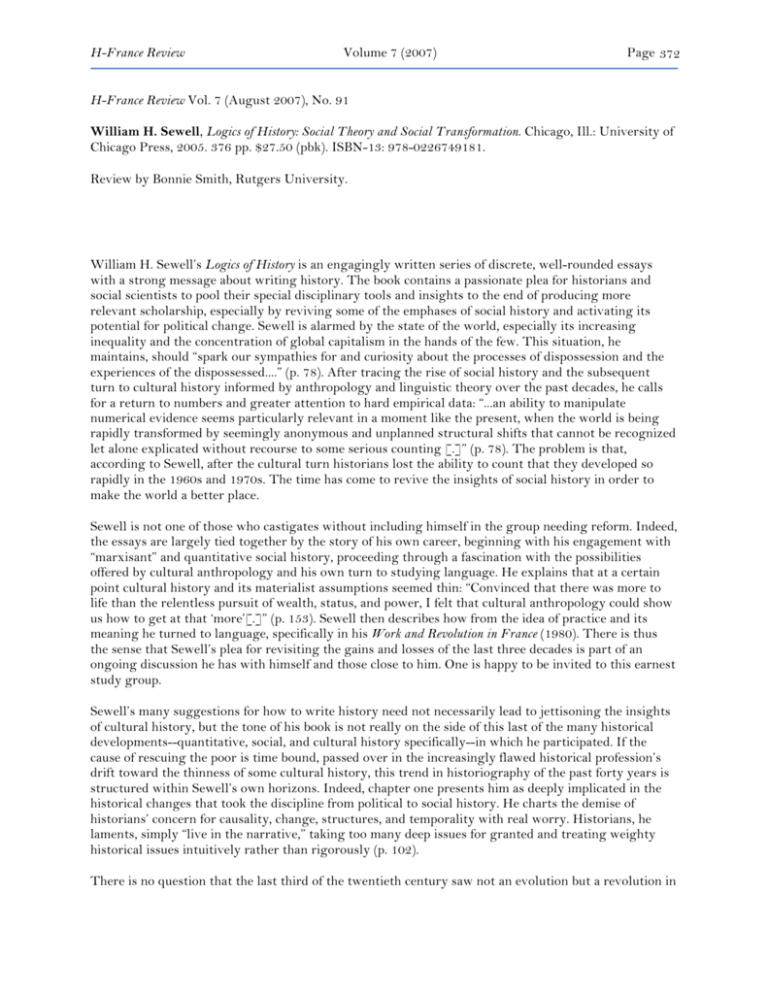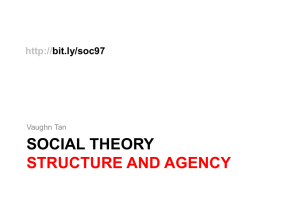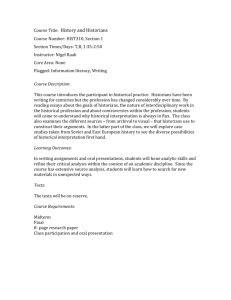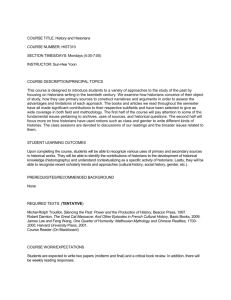
H-France Review
Volume 7 (2007)
Page 372
H-France Review Vol. 7 (August 2007), No. 91
William H. Sewell, Logics of History: Social Theory and Social Transformation. Chicago, Ill.: University of
Chicago Press, 2005. 376 pp. $27.50 (pbk). ISBN-13: 978-0226749181.
Review by Bonnie Smith, Rutgers University.
William H. Sewell’s Logics of History is an engagingly written series of discrete, well-rounded essays
with a strong message about writing history. The book contains a passionate plea for historians and
social scientists to pool their special disciplinary tools and insights to the end of producing more
relevant scholarship, especially by reviving some of the emphases of social history and activating its
potential for political change. Sewell is alarmed by the state of the world, especially its increasing
inequality and the concentration of global capitalism in the hands of the few. This situation, he
maintains, should “spark our sympathies for and curiosity about the processes of dispossession and the
experiences of the dispossessed....” (p. 78). After tracing the rise of social history and the subsequent
turn to cultural history informed by anthropology and linguistic theory over the past decades, he calls
for a return to numbers and greater attention to hard empirical data: “...an ability to manipulate
numerical evidence seems particularly relevant in a moment like the present, when the world is being
rapidly transformed by seemingly anonymous and unplanned structural shifts that cannot be recognized
let alone explicated without recourse to some serious counting [.]” (p. 78). The problem is that,
according to Sewell, after the cultural turn historians lost the ability to count that they developed so
rapidly in the 1960s and 1970s. The time has come to revive the insights of social history in order to
make the world a better place.
Sewell is not one of those who castigates without including himself in the group needing reform. Indeed,
the essays are largely tied together by the story of his own career, beginning with his engagement with
“marxisant” and quantitative social history, proceeding through a fascination with the possibilities
offered by cultural anthropology and his own turn to studying language. He explains that at a certain
point cultural history and its materialist assumptions seemed thin: “Convinced that there was more to
life than the relentless pursuit of wealth, status, and power, I felt that cultural anthropology could show
us how to get at that ‘more’[.]” (p. 153). Sewell then describes how from the idea of practice and its
meaning he turned to language, specifically in his Work and Revolution in France (1980). There is thus
the sense that Sewell’s plea for revisiting the gains and losses of the last three decades is part of an
ongoing discussion he has with himself and those close to him. One is happy to be invited to this earnest
study group.
Sewell’s many suggestions for how to write history need not necessarily lead to jettisoning the insights
of cultural history, but the tone of his book is not really on the side of this last of the many historical
developments--quantitative, social, and cultural history specifically--in which he participated. If the
cause of rescuing the poor is time bound, passed over in the increasingly flawed historical profession’s
drift toward the thinness of some cultural history, this trend in historiography of the past forty years is
structured within Sewell’s own horizons. Indeed, chapter one presents him as deeply implicated in the
historical changes that took the discipline from political to social history. He charts the demise of
historians’ concern for causality, change, structures, and temporality with real worry. Historians, he
laments, simply “live in the narrative,” taking too many deep issues for granted and treating weighty
historical issues intuitively rather than rigorously (p. 102).
There is no question that the last third of the twentieth century saw not an evolution but a revolution in
H-France Review
Volume 7 (2007)
Page 373
history writing, and it is this revolution whose energies Sewell sets out to redirect. Logics of History
devotes ten methodological and theoretical essays, some addressed primarily to historians and some to
sociologists, anthropologists and other social scientists to this task. All of the essays should appeal to
both audiences. The audience is large because Sewell rightly sees that the field of historical engagement
is large, spanning the social sciences and humanities. A brief introduction lays out the book’s raison
d’être--that is, to help historians become more able theorists and social scientists to develop a better
grasp of temporality, contingency, and events--all in order to return historical writing to a surer
scientific footing and to make it more useful. To date, Sewell maintains, historians treat such matters as
causality and change casually, while social scientists have heretofore lacked historians’ grasp of detail
and change over time. So it is that historians in his view need to become more theoretically acute,
though not necessarily in theories arising from continental philosophy and attached to ontology and
linguistics. Rather historians need to hew to the more epistemological side of the equation, theorizing
events in the more positivist way. Indeed the portions of the book addressed to historians strongly
suggest that historians have lost their way in the analytical world because they have eschewed positivist
theory. This is a bit of an overstatement because the book drifts from law-like social scientific
pronouncements to a variety of other positions. Moreover, Sewell never explicitly calls for a return to
nineteenth-century positivism, but the undertone is there even though the material in chapter ten and
elsewhere is polyvalent.
In contrast, social scientists have avoided issues of temporality and contingency, leaving their discipline
weighted with theory that may have nothing to do with reality and that especially cannot explain it.
Although social scientists may be expert at theorizing structures, for example, they have not generated
any means for explaining change or showing how change can emerge from structures. They cannot deal
with messiness, leading Sewell to ask of sociologists and other social scientists “strip [their writings
about history] of inappropriate scientific rhetoric [.]” (p. 112). Focusing on the work of Pierre
Bourdieu, Sewell himself then proposes five axioms that will let structures “generate transformation,”
putting him largely and perhaps inadvertently in the scientific camp (p. 139).
Historians like me who love detail and contingency may well revel in this critique of social theorists, but
Sewell’s challenge to historians is just as powerful. One notes that the presentation of “axioms,” for
example, is itself “scientific rhetoric” and for all the criticism of social theorists’ scientism, Sewell
criticizes historians for not having enough of it, although the explicit charge is that they don’t have
enough “theory.” This, however, seems to mean at times a lack of conceptual tools to draw out the
maxims and proper laws of social change and to test hypotheses. Simultaneously, Sewell calls on us to
write “eventful” history. His model event is the taking of the Bastille, and in his theoretical presentation
of this particular “event,” Sewell provides moments of thumping narrative (shots, bodily dismembering,
heads on pikes), however brief, followed by calm and lucid theorizing. Although some may charge that
this example returns us to the canonical grand narrative of the 1960s, in fact the creative potential is
great, and Sewell’s call has already been heard and implemented by important historians in ways that do
not completely fit the model. Mrinalini Sinha’s Specters of Mother India (2006) uses the 1926 publication
of U.S. author Katherine Mayo’s Mother India as a Sewell-validated “event,” for the work galvanized
nationalists to challenge Britain and Indian feminists to mobilize in effective ways, all the while
discrediting British rule--the opposite of Mayo’s intention. However, unlike Sewell’s example of the
taking of the Bastille, the structures that for a moment are open to challenge in fact do not change in
Sinha’s account.
Another essay on the dockworkers of Marseilles, a topic of special interest to French and labor
historians, engages issues of continuity in structures where little seems to change for dockworkers
despite transformation in economic structures and the advance of capitalism. Sewell sets himself the task
in this chapter to show how to write a theory-driven history, one that will test hypotheses and yield
theories. French historians will particularly enjoy this exercise because it takes them through the
minutiae of Marseilles worker activism between 1840 and the end of the century. The chapter concludes
H-France Review
Volume 7 (2007)
Page 374
with an analysis of the uneven results for workers at a time of economic transformation and, like the
essay on social history, shows Sewell’s historical and theoretical eclecticism.
“Refiguring the Social” is a mini-primer for graduate students and professionals interested not only in a
discussion of language but of hearing about “social construction” and a brief for quantitative methods.
Sewell’s vision of the social is that it is (a) a matter of ontology; (b) a language game; and (c) a built
environment. In developing his argument that culture (and almost everything else) is contained in the
social, Sewell uses the work of Keith Baker on political culture, amplifying it theoretically to include
kinesthetic and other gestures as part of the language game of society. Here perhaps is the only place
where some readers may lose their way, as the limitations Sewell finds in Baker’s thought are basically
explained--at length and at various points in the chapter--using the techniques and professional
terminology of a basketball game. I’ve alluded to what this metaphor and the later use of baseball may
mean in “The Gender of History” (1998). Categorizing the social in three such disparate--some would
say incompatible or even inappropriate--terms point to another major feature of Sewell’s thought: its
eclecticism. Bourdieu laced with Thomas Kuhn laced with Immanuel Kant inflected by Baker and dozens
of others makes for quite a cast of characters alongside a cornucopia of paradigms and pronouncements.
Some will find this eclecticism maddening, while for others it points to a capacious historical vision that
allows for incompatibilities in historical rhetoric, models, and meaning. Hence the plural term “logics.”
One should warn readers in conclusion that this is a dense, if clear and vigorous work--not a quick read.
It is packed with French history, French historians, and French theorists--disparate threads woven into
a very rich tapestry. While highly charged in terms of argument and rich in details, however, it is a
refreshingly open book, which makes the reading all the more demanding and more involved. Given this
eclecticism and the Siberian quantity of trees, one hungered at the end for the contours of the forest,
provided optimally in some final thoughts by way of conclusion or even a gesture (see chapter ten on
gestures) acknowledging the reader’s dizziness so as to reset his or her balance. How do we in a nutshell
reconcile the competing claims of science, the politics of capitalism, eventful history, structural theory,
the varieties of cultural analysis, the built environment, and a host of other historical tools and ideas
mustered in this work? Although Sewell concludes his final essay on social history with the claim that
everything works together and that nothing is really incompatible (but rather dialectically related),
Sewell does not give us an extended final word, pointing perhaps to further discussion and an open
future for the profession.
Bonnie Smith Rutgers University bosmith@rci.rutgers.edu
Copyright © 2007 by the Society for French Historical Studies, all rights reserved. The Society for
French Historical Studies permits the electronic distribution for nonprofit educational purposes,
provided that full and accurate credit is given to the author, the date of publication, and its location on
the H-France website. No republication or distribution by print media will be permitted without
permission. For any other proposed uses, contact the Editor-in-Chief of H-France.
H-France Review Vol. 7 (July 2007), No. 91
ISSN 1553-9172









